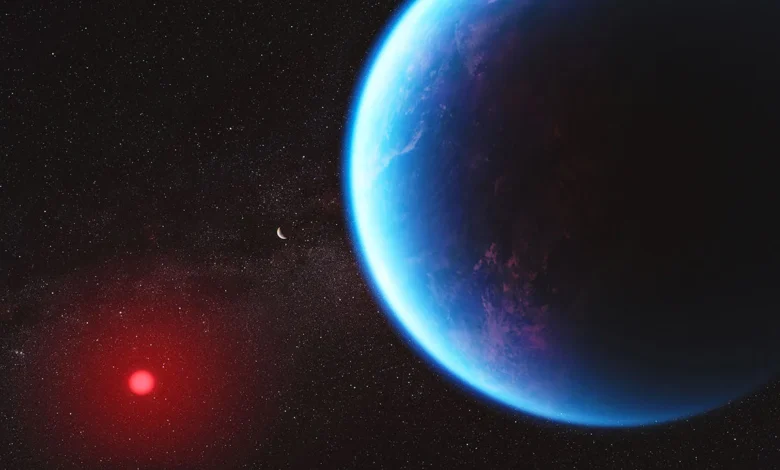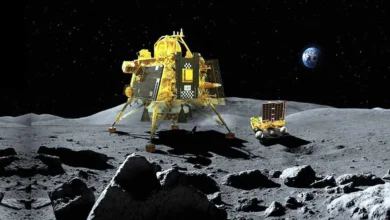Exploring life in other worlds? Exciting findings in the search for alien life
Carbon dioxide, methane, and perhaps dimethyl sulfide—a substance not often seen in environments devoid of life—have been detected in the atmosphere of the exoplanet K2-18b. It may open up a new path in the search for extraterrestrial life known as Hycean worlds.

Life on other planets? Although the James Webb Space Telescope’s launch in 2021 has accelerated the search, we still don’t know the answer. As a result, exciting new hypotheses have surfaced.
K2-18b is an exoplanet that circles the star K2 120 light years away from Earth, beyond the Solar System. Webb’s observations of its atmosphere have now confirmed the existence of carbon dioxide and methane, two substances that are both strong indicators of life. Although this does not prove that life exists there, K2-18b is a fascinating study subject because of two other factors.
One is a “tentative” discovery that has to be confirmed: dimethyl sulfide, a molecule closely related to life, also seems to be present in the atmosphere of K2-18b. It is only known to be created on Earth by algae and other similar lifeforms.
The likelihood that K2-18b belongs to the hypothetical category of celestial bodies known as Hycean worlds is an additional intriguing element. Hycean worlds are promoted by those who support the notion as the best places to look for evidence of alien life.
Astrophysicist Nikku Madhusudan of Cambridge University responded by email, saying, “The idea of Hycean worlds was just proposed lately, in 2021, and was a theoretical innovation. The team that initially put out the idea was led by Madhusudan, who is also the primary author of the most recent study on K2-18b (The Astrophysics Journal, 2021). The Astrophysical Journal Letters has approved the new work for publication, he reported.
If they do contain life, Madhusudan added, “Hycean worlds are significantly more accessible for atmospheric observations and are therefore more likely to reveal possible signatures of life than rocky planets.”
Understanding what it means to look for “signatures of life” is helpful before discussing what Hycean worlds are like.
What to watch out for?
The mixture of gases in the atmosphere of a planet or distant moon would most likely include indications of life. These would be an indicator (not a confirmation) of life if the mixture contained oxygen, carbon dioxide, and methane, comparable to that found in Earth’s atmosphere.
Transmission spectroscopy, the study of light in the atmosphere as seen from Earth, is used by scientists to investigate the atmospheric composition. Reading such wavelengths aids in the identification of the components since different materials absorb and emit light at various wavelengths.
Additionally, the chemistry of nearby celestial bodies is studied via spectroscopy. as, say, the moon Europa of Jupiter. Scientists have concluded from two recent investigations that the solid carbon dioxide that was previously discovered on Europa’s surface was formed from an internal carbon source. The findings suggest that carbon dioxide produced directly in the ocean below Europa’s frozen crust, however they do not completely rule out the possibility of its production on the surface (from material derived from the ocean).
One of the two papers’ authors, planetary scientist Samantha Trumbo of Cornell University, told HT that “in all of those possibilities, the carbon we see on the surface is primarily originating from the internal ocean, which is an important finding for ultimately understanding the habitability of Europa’s ocean.”
Results can start off looking good but turn out to be disappointing. An article in Nature in 2018 hypothesized that phosphine, a chemical produced by microorganisms on Earth, was present in Venus’ atmosphere. However, a later research revealed flaws in that investigation and excluded phosphine.
To return to exoplanets, there are a few important factors to take into account while looking for indications of life.
First, for water to exist as a liquid, a planet has to be in the “habitable zone” or at the ideal distance from its star. What sort of exoplanet is best for studying the atmosphere, secondly? Hycean worlds have a role in this.
Fresh opportunities
There is a class of exoplanets known as sub-Neptunes, which range in size from Earth to Neptune. One of the theories developed by studies for what they may be formed of is the “Hycean world” model. A sub-Neptune with a thin atmosphere rich in hydrogen sitting on top of an ocean of water is called a hycean world.
“Additional theoretical research suggested that, if such an ocean were to exist, we would observe a certain pattern of gases in the atmosphere. We really saw this trend in our observations of K2-18 b, which leads us to believe that an ocean of water could exist there. Thus, this increases the likelihood that such planets support life, according to Cardiff University astrophysicist Subhajit Sarkar, one of the paper’s authors.
Rockier planets in the habitable zone have so far been the focus of the hunt for life since it is assumed that they would likely have seas of liquid water, just like Earth. Now, a potential substitute is provided by the notion of ocean-filled Hycean worlds. It is more difficult to get an atmospheric spectrum from rocky planets than it is from sub-Neptunes for a variety of technical reasons. Therefore, Sarkar stated, “If biosignatures did exist, they would be simpler to detect on the Hycean planet, even though at this moment we have no clue whether Hycean planets are more or less likely to harbor life than rocky planets.
As for the findings, Nasa has announced the detection of carbon dioxide and methane on K2-18b but made it clear that the inference on dimethyl sulphide is “less robust and requires further validation”. Madhusudan and Sarkar, too, stressed this point.
The discovery of methane is exciting in and of itself. Methane hasn’t been discovered on exoplanets with chilly, hydrogen-rich atmospheres, despite the fact that it is predicted to be plentiful in such environments. “Our detections of methane and carbon dioxide are the first detections of any carbon-bearing molecules in a habitable-zone exoplanet,” Madhusudan stated.
It is crucial to remember that methane, carbon dioxide, or even dimethyl sulfide are “signatures of life,” not life itself, even if their existence is confirmed. According to NASA, the most that researchers can do in their quest for these clues is an estimation of the likelihood that life exists.
“However, a discovery of an exoplanet with, say, a 95% probability of life would be a historic game changer.”
The time of first encounter is drawing near.
Please, also have a look into : ‘It was alive’: Mexican doctors examine non-human-like alien bodies



